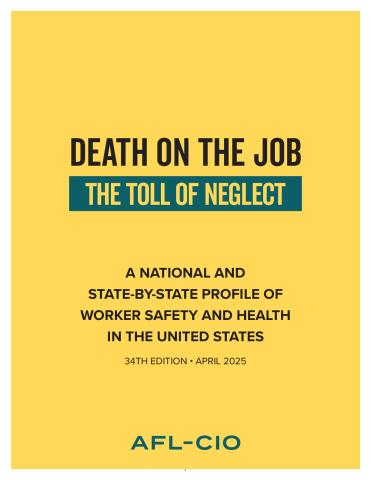
Despite significant advancements in workplace health and safety over the past four decades, 150 people will be killed on the job or die from job-related illnesses and diseases today, reports the 2014 edition of the AFL-CIO’s annual Death on the Job: The Toll of Neglect, released this morning.
And that daily death toll, which has remained steady for the past several years, plus the 11.4 million work-related injuries and illnesses a year show:
The nation must renew the commitment to protect workers from injury, disease and death and make this a high priority. We must demand that employers meet their responsibilities to protect workers and hold them accountable if they put workers in danger. Only then can the promise of safe jobs for all of America’s workers be fulfilled.
Overall in 2012 (the last figures available from the U.S. Bureau of Labor Statistics) 4,628 workers were killed on the job in the United States, and an estimated 50,000 died from occupational diseases, Nearly 3.8 million work-related injuries and illnesses were reported, but many injuries are not reported. The true toll is likely two to three times greater or 7.6 million to 11.4 million injuries a year.
“A hard day’s work should not be a death sentence,” says AFL-CIO President Richard Trumka. “It is unconscionable that any worker has to choose between life and putting food on the table. When Congress votes to weaken worker protections or defund critical programs and when big corporations marginalize and de-emphasize worker safety, they insult the memory of all those workers who have died while fighting to attain the American Dream.”
The report includes state-by-state profiles of workers’ safety and health and features state and national information on workplace fatalities, injuries, illnesses, the number and frequency of workplace inspections, penalties, funding, staffing and public employee coverage under the Occupational Safety and Health Act.
This year, along with being able to download PDFs of the entire report or various sections, you can access the data that comprise the report on Socrata, an online database designed to make datasets more accessible to the public. View the charts here.
Here are some key facts from Death on the Job: The Toll of Neglect:
North Dakota is the nation’s most deadly state for workers. Its fatality rate of 17.7 deaths per 100,000 workers is five times the national average; one of the highest every reported; and has more than doubled since 2007. From 2011 to 2102, the number of workers killed on the job in North Dakota jumped from 25 to 64.
In mining and oil extraction, North Dakota’s death rate is more than six times the national average and its construction job fatality rates is nearly 10 times the national average.
Wyoming, Alaska, Montana and West Virginia are the next deadliest states while Massachusetts, Rhode Island, Connecticut, Washington State and California had the lowest fatality rates.
Latino workers, especially those born outside of the United States, continue to face higher rates of workplace fatalities and accounted for 748 of 2012’s on-the-job deaths.
In the area of job safety enforcement, the report says the Occupational Safety and Health Administration (OSHA) and Mine Safety and Health Administration (MSHA) remain underfunded and understaffed. In fact, at current staffing levels, it would take OSHA 139 years to inspect the nation’s 8 million workplaces. In addition, current civil and criminal penalties are far too low to deter employers from violating the law.
Death on the Job notes that the Obama administration has returned OSHA and MSHA to their missions to protect workers’ safety and health, appointing strong, pro-worker safety and health advocates to head the agencies, and increasing funding, staffing and stepped up enforcement. However:
After eight years of neglect and inaction under the Bush administration, progress in issuing new needed protections under the Obama administration has been slow and disappointing. The Office of Management and Budget (OMB) has blocked and delayed important rules. Since 2009, only four major final OSHA safety and health standards have been issued.
But recently there has been somewhat of a thaw in the regulatory freeze, including last year’s release of a tougher new rule on silica dust exposure that OMB has blocked for two and a half years. Last month, MSHA issued a final standard to reduce coal miners’ exposure to coal dust that causes black lung disease.
Several other long overdue rules remain stalled, including OSHA rules on confined space entry in construction, beryllium, combustible dust and infectious diseases; and MSHA rules on proximity detection/collision warning systems on mining equipment to warn of dangerously nearby workers or other equipment.
The time for the Obama administration to act on these rules is running out.
Death on the Job calls for several measures to improve job safety, save lives and prevent injuries, including:
- Increased funding for OSHA and MSHA to enhanced oversight of worksites and timely and effective enforcement.
- Remedying the widespread problem of injury underreporting and prohibiting employer policies and practices that discourage the reporting of injuries through discipline or other means.
- Addressing the increased risk of fatalities and injuries faced by Latino and immigrant workers and rise of fatalities and injuries in the oil and gas extraction industry.
The report also says the Mine Safety and Health Act must be strengthened to give MSHA more authority to enhance enforcement against repeated violators and to shut down dangerous mines. It also calls for congressional passage of the Protecting America’s Workers Act to extend the law’s coverage to workers currently excluded, strengthen civil and criminal penalties for violations, enhance anti-discrimination protections and strengthen the rights of workers, unions and victims.



